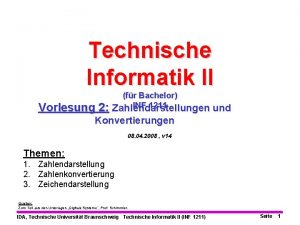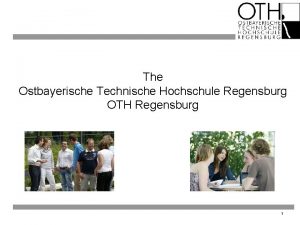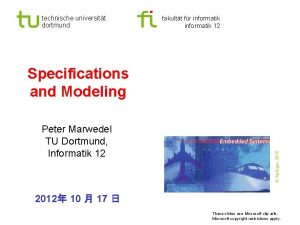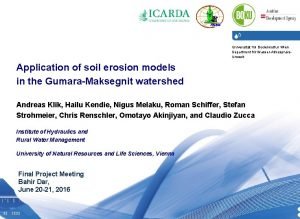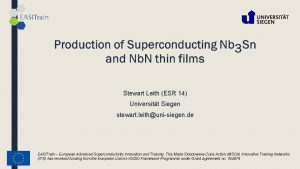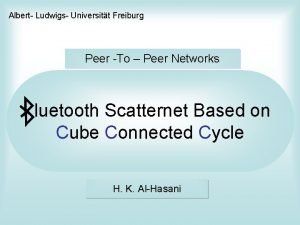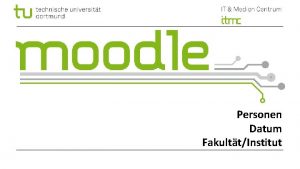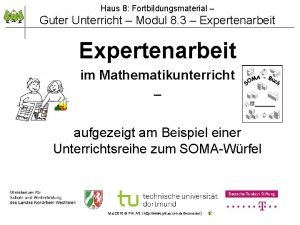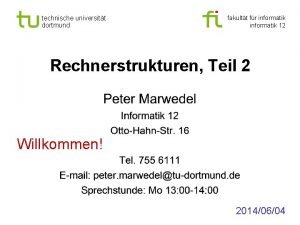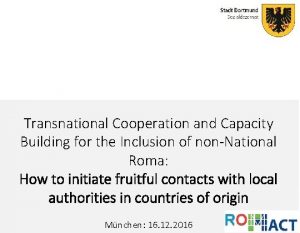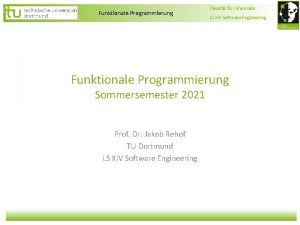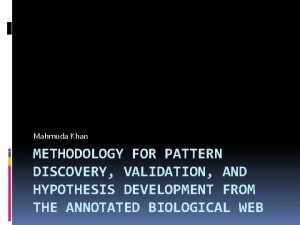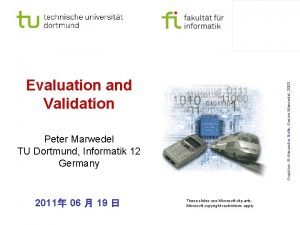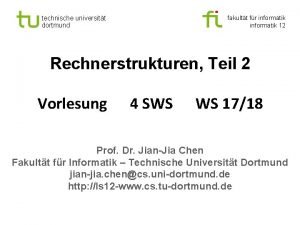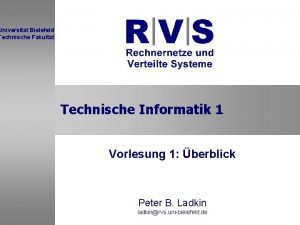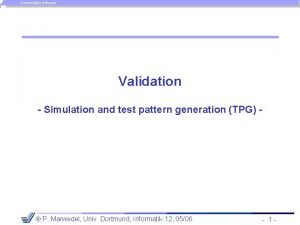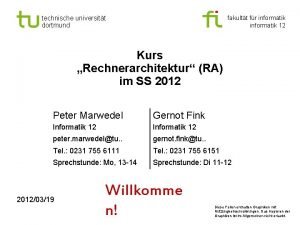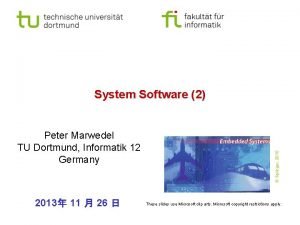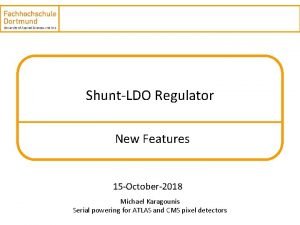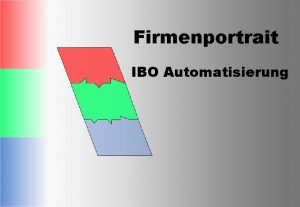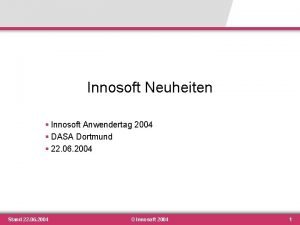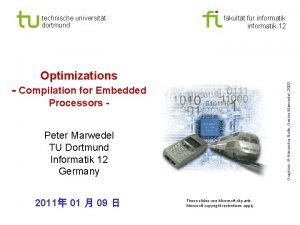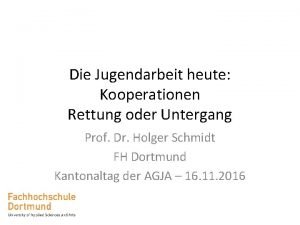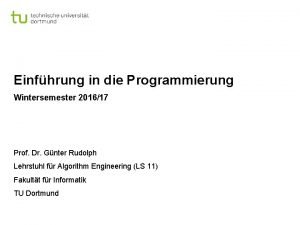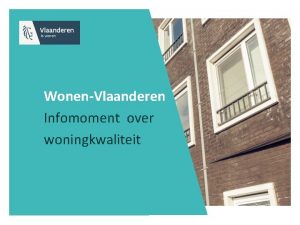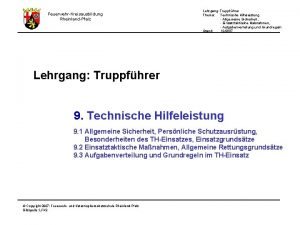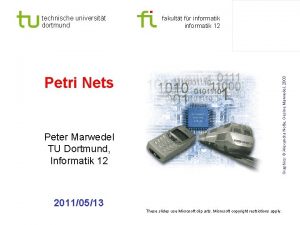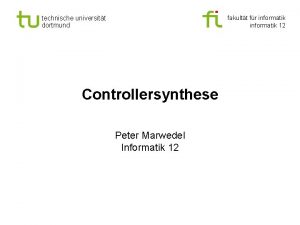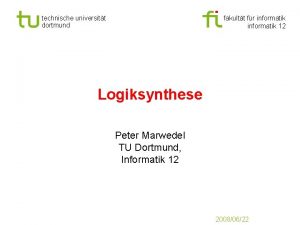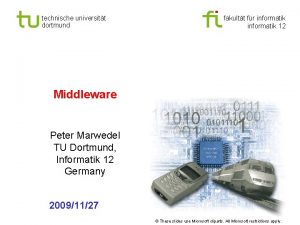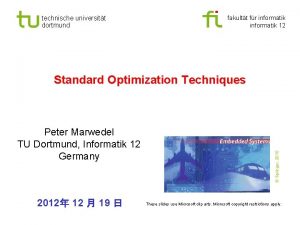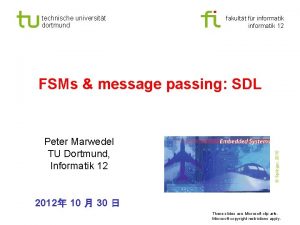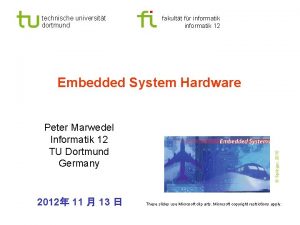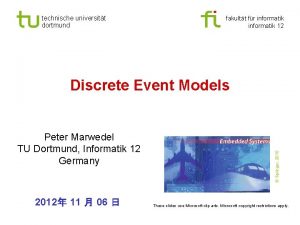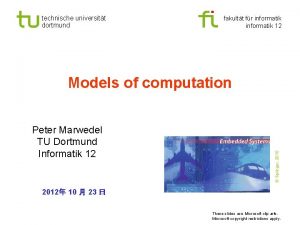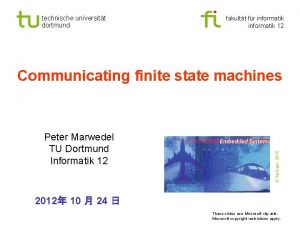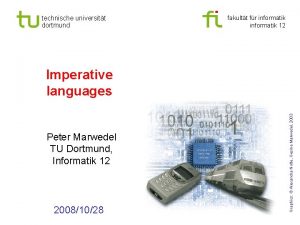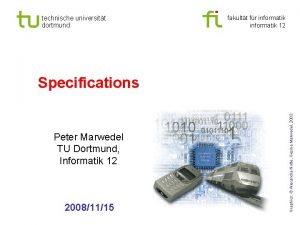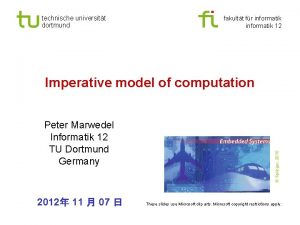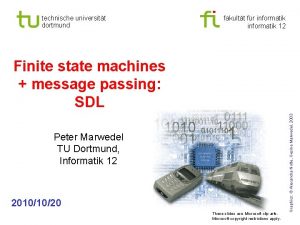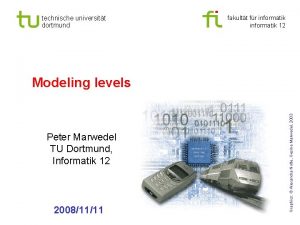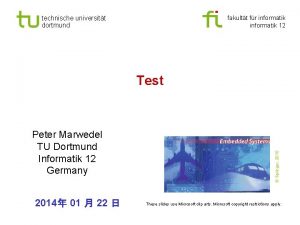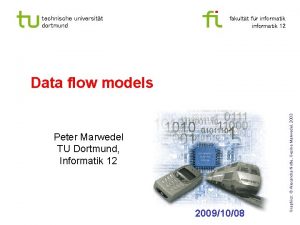technische universitt dortmund fakultt fr informatik 12 Peter















![General form of edge labels event [condition] / reaction Events: § Exist only until General form of edge labels event [condition] / reaction Events: § Exist only until](https://slidetodoc.com/presentation_image_h2/1af135db8186c61e4beea77cbe4269f5/image-16.jpg)





















- Slides: 37

technische universität dortmund fakultät für informatik 12 Peter Marwedel TU Dortmund, Informatik 12 2008/10/10 Graphics: © Alexandra Nolte, Gesine Marwedel, 2003 State. Charts

State. Charts Used here as a (prominent) example of a model of computation based on shared memory communication. appropriate only for local (nondistributed) systems technische universität dortmund fakultät für informatik p. marwedel, informatik 12, 2008 - 2 -

Models of computation considered in this course Communication/ local computations Shared memory Communicating finite state machines Data flow model State. Charts Not useful Computational graphs Message passing Synchronous | Asynchronous SDL Simulink Kahn process networks, SDF Sequence diagram, Petri nets Von Neumann model C, C++, Java Discrete event (DE) model VHDL, … technische universität dortmund fakultät für informatik C, C++, Java with libraries CSP, ADA | Only experimental systems, e. g. distributed DE in Ptolemy p. marwedel, informatik 12, 2008 - 3 -

State. Charts: recap of classical automata Classical automata: input X clock Internal state Z output Y Moore- + Mealy automata=finite state machines (FSMs) Next state Z+ computed by function Output computed by function • Moore-automata: Y = (Z); Z+ = (X, Z) • Mealy-automata Y = (X, Z); Z+ = (X, Z) technische universität dortmund fakultät für informatik Z 0 0 e=1 Z 3 3 p. marwedel, informatik 12, 2008 e=1 Z 1 1 e=1 Z 2 e=1 2 - 4 -

State. Charts Classical automata not useful for complex systems (complex graphs cannot be understood by humans). Introduction of hierarchy State. Charts [Harel, 1987] State. Chart = the only unused combination of „flow“ or „state“ with „diagram“ or „chart“ technische universität dortmund fakultät für informatik p. marwedel, informatik 12, 2008 - 5 -

Introducing hierarchy FSM will be in exactly one of the substates of S is active (either in A or in B or. . ) technische universität dortmund fakultät für informatik p. marwedel, informatik 12, 2008 - 6 -

Definitions § Current states of FSMs are also called active states. § States which are not composed of other states are called basic states. § States containing other states are called super-states. § For each basic state s, the super-states containing s are called ancestor states. § Super-states S are called OR-super-states, if exactly one of the sub-states of S is active whenever S is active. superstate ancestor state of E substates technische universität dortmund fakultät für informatik p. marwedel, informatik 12, 2008 - 7 -

Default state mechanism Try to hide internal structure from outside world! Default state Filled circle indicates sub-state entered whenever super-state is entered. Not a state by itself! technische universität dortmund fakultät für informatik p. marwedel, informatik 12, 2008 - 8 -

History mechanism (behavior different from last slide) km For input m, S enters the state it was in before S was left (can be A, B, C, D, or E). If S is entered for the first time, the default mechanism applies. History and default mechanisms can be used hierarchically. technische universität dortmund fakultät für informatik p. marwedel, informatik 12, 2008 - 9 -

Combining history and default state mechanism same meaning technische universität dortmund fakultät für informatik p. marwedel, informatik 12, 2008 - 10 -

Concurrency Convenient ways of describing concurrency are required. AND-super-states: FSM is in all (immediate) sub-states of a super-state; Example: technische universität dortmund fakultät für informatik p. marwedel, informatik 12, 2008 - 11 -

Entering and leaving AND-super-states incl. Line-monitoring and key-monitoring are entered and left, when service switch is operated. technische universität dortmund fakultät für informatik p. marwedel, informatik 12, 2008 - 12 -

Types of states In State. Charts, states are either § basic states, or § AND-super-states, or § OR-super-states. technische universität dortmund fakultät für informatik p. marwedel, informatik 12, 2008 - 13 -

Timers Since time needs to be modeled in embedded systems, timers need to be modeled. In State. Charts, special edges can be used for timeouts. If event a does not happen while the system is in the left state for 20 ms, a timeout will take place. technische universität dortmund fakultät für informatik p. marwedel, informatik 12, 2008 - 14 -

Using timers in an answering machine . technische universität dortmund fakultät für informatik p. marwedel, informatik 12, 2008 - 15 -
![General form of edge labels event condition reaction Events Exist only until General form of edge labels event [condition] / reaction Events: § Exist only until](https://slidetodoc.com/presentation_image_h2/1af135db8186c61e4beea77cbe4269f5/image-16.jpg)
General form of edge labels event [condition] / reaction Events: § Exist only until the next evaluation of the model § Can be either internally or externally generated Conditions: § Refer to values of variables that keep their value until they are reassigned Reactions: § Can either be assignments for variables or creation of events Example: § service-off [not in Lproc] / service: =0 technische universität dortmund fakultät für informatik p. marwedel, informatik 12, 2008 - 16 -

The State. Charts simulation phases (State. Mate Semantics) How are edge labels evaluated? Three phases: 1. Effect of external changes on events and conditions is evaluated, 2. The set of transitions to be made in the current step and right hand sides of assignments are computed, 3. Transitions become effective, variables obtain new values. Separation into phases 2 and 3 guarantees deterministic and reproducible behavior. technische universität dortmund fakultät für informatik p. marwedel, informatik 12, 2008 - 17 -

Example In phase 2, variables a and b are assigned to temporary variables. In phase 3, these are assigned to a and b. As a result, variables a and b are swapped. In a single phase environment, executing the left state first would assign the old value of b (=0) to a and b. Executing the right state first would assign the old value of a (=1) to a and b. The execution would be non-deterministic. technische universität dortmund fakultät für informatik p. marwedel, informatik 12, 2008 - 18 -

Reflects model of clocked hardware In an actual clocked (synchronous) hardware system, both registers would be swapped as well. Same separation into phases found in other languages as well, especially those that are intended to model hardware. technische universität dortmund fakultät für informatik p. marwedel, informatik 12, 2008 - 19 -

Steps Execution of a State. Mate model consists of a sequence of (status, step) pairs Status= values of all variables + set of events + current time Step = execution of the three phases (State. Mate semantics) 1 e s a ph Status phase technische universität dortmund phase 2 3 fakultät für informatik Other implementations of State. Charts do not have these 3 phases (and hence are nondeterministic)! p. marwedel, informatik 12, 2008 - 20 -

Other semantics Several other specification languages for hierarchical state machines (UML, dave, …) do not include three simulation phases. These correspond more to a SW point of view with no synchronous clocks. Lab. View seems to allow turning the multiphased simulation on and off. technische universität dortmund fakultät für informatik p. marwedel, informatik 12, 2008 - 21 -

Broadcast mechanism Values of variables are visible to all parts of the State. Chart model New values become effective in phase 3 of the current step and are obtained by all parts of the model in the following step. ! State. Charts implicitly assumes a broadcast mechanism for variables ( implicit shared memory communication –other implementations would be very inefficient -). State. Charts is appropriate for local control systems ( ), but not for distributed applications for which updating variables might take some time ( ). technische universität dortmund fakultät für informatik p. marwedel, informatik 12, 2008 - 22 -

Lifetime of events Events live until the step following the one in which they are generated („one shot-events“). technische universität dortmund fakultät für informatik p. marwedel, informatik 12, 2008 - 23 -

State. Charts deterministic or not? Deterministic (in this context) means: Must all simulators return the same result for a given input? § Separation into 2 phases a required condition § Semantics State. Mate semantics may be non-deterministic Potential other sources of non-deterministic behavior: § Choice between conflicting transitions resolved arbitrarily A A Tools typically issue a warning if such non-determinism could exist Deterministic behavior for State. Mate semantics if transition conflicts are resolved deterministically and no other sources of non-determinism exist technische universität dortmund fakultät für informatik p. marwedel, informatik 12, 2008 - 24 -

Evaluation of State. Charts (1) Pros: § Hierarchy allows arbitrary nesting of AND- and OR-super states. § (State. Mate-) Semantics defined in a follow-up paper to original paper. § Large number of commercial simulation tools available (State. Mate, State. Flow, Better. State, . . . ) § Available „back-ends“ translate State. Charts into C or VHDL, thus enabling software or hardware implementations. technische universität dortmund fakultät für informatik p. marwedel, informatik 12, 2008 - 25 -

Evaluation of State. Charts (2) Cons: § Generated C programs frequently inefficient, § Not useful for distributed applications, § No program constructs, § No description of non-functional behavior, § No object-orientation, § No description of structural hierarchy. Extensions: § Module charts for description of structural hierarchy. technische universität dortmund fakultät für informatik p. marwedel, informatik 12, 2008 - 26 -

Synchronous vs. asynchronous languages (1) Description of several processes in many languages nondeterministic: The order in which executable tasks are executed is not specified (may affect result). Synchronous languages: based on automata models. “Synchronous languages aim at providing high level, modular constructs, to make the design of such an automaton easier [Nicolas Halbwachs]. Synchronous languages describe concurrently operating automata. “. . when automata are composed in parallel, a transition of the product is made of the "simultaneous" transitions of all of them“. © P. Marwedel, 2008 technische universität dortmund fakultät für informatik p. marwedel, informatik 12, 2008 - 27 -

Synchronous vs. asynchronous languages (2) Synchronous languages implicitly assume the presence of a (global) clock. Each clock tick, all inputs are considered, new outputs and states are calculated and then the transitions are made. technische universität dortmund fakultät für informatik p. marwedel, informatik 12, 2008 - 28 -

Abstraction of delays Let § f(x): some function computed from input x, § (f(x)): the delay for this computation § : some abstraction of the real delay (e. g. a safe bound) Consider compositionality: f(x)=g(h(x)) Then, the sum of the delays of g and h would be a safe upper bound on the delay of f. Two solutions: 1. =0, always synchrony 2. =? (hopefully bounded) asynchrony Asynchronous languages don’t work [Halbwachs] (Examples based on missing link to real time, e. g. what exactly does a wait(10 ns) in a programming language do? ) technische universität dortmund fakultät für informatik Based slide 15 of N. Halbwachs: Synchronous Programming of Reactive p. onmarwedel, Systems, ARTIST 2 informatik 12, Summer 2008 School on Embedded Systems, Florianopolis, 2008 - 29 -

Compositionality At the abstract level, a single FSM reacts immediately At the abstract level, reaction of connected other automata is immediate Based on slide 16 of N. Halbwachs: Synchronous Programming of Reactive Systems, ARTIST 2 Summer School on Embedded Systems, Florianopolis, 2008 technische universität dortmund fakultät für informatik p. marwedel, informatik 12, 2008 - 30 -

Concrete Behavior The abstraction of synchronous languages is valid, as long as real delays are always shorter than the clock period. Reference: slide 17 of N. Halbwachs: Synchronous Programming of Reactive Systems, ARTIST 2 Summer School on Embedded Systems, Florianopolis, 2008 technische universität dortmund fakultät für informatik p. marwedel, informatik 12, 2008 - 31 -

Synchronous languages § Require a broadcast mechanism for all parts of the model. § Idealistic view of concurrency. § Have the advantage of guaranteeing deterministic behavior. § State. Charts (using State. Mate semantics) is an “almost” synchronous language [Halbwachs]. Immediate communication is the lacking feature which would make State. Charts a fully synchronous language. technische universität dortmund fakultät für informatik p. marwedel, informatik 12, 2008 - 32 -

Implementation and specification model For synchronous languages, the implementation model is that of finite state machines (FSMs). The specification may use different notational styles § “Imperative”: Esterel (textual) § Sync. Charts: graphical version of Esterel § “Data-flow”: Lustre (textual) § SCADE (graphical) is a mix containing elements from multiple styles Nevertheless, specifications always include a close link to the generated FSMs (i. e. , “imperative” does not have semantics close to von-Neumann languages) technische universität dortmund fakultät für informatik p. marwedel, informatik 12, 2008 - 33 -

Applications SCADE Suite, including the SCADE KCG Qualified Code Generator, is used by AIRBUS and many of its main suppliers for the development of most of the A 380 and A 400 M critical on board software, and for the A 340 -500/600 Secondary Flying Command System, aircraft in operational use since August 2002. François Pilarski, Systems Engineering Framework - Senior Manager Engineering, Systems & Integration Tests; Airbus France. Instance of “model-based design” Source: http: //www. estereltechnologies. com/products/scade-suite/ technische universität dortmund fakultät für informatik p. marwedel, informatik 12, 2008 - 34 -

technische universität dortmund fakultät für informatik p. marwedel, informatik 12, 2008 - 35 -

Summary State. Charts as an example of shared memory Mo. Cs § AND-states § OR-states § Timer § Broadcast § Semantics • multi-phase models • single-phase models Synchronous languages § Based on clocked finite state machine view § Based on 0 -delay (valid as long as real delays are small enough) technische universität dortmund fakultät für informatik p. marwedel, informatik 12, 2008 - 36 -

Questions? Q&A? technische universität dortmund fakultät für informatik p. marwedel, informatik 12, 2008 - 37 -
 Technische informatik 2 tu bs
Technische informatik 2 tu bs Oth regensburg exchange
Oth regensburg exchange Rechnerstrukturen tu dortmund
Rechnerstrukturen tu dortmund Universitt
Universitt Harvard universitt
Harvard universitt Ccc freiburg
Ccc freiburg Universitt wien
Universitt wien Wgh dortmund
Wgh dortmund Tu dortmund unimaik
Tu dortmund unimaik Pikas uni dortmund
Pikas uni dortmund Studentensekretariat tu dortmund
Studentensekretariat tu dortmund Rechnerstrukturen tu dortmund
Rechnerstrukturen tu dortmund Lego dortmund
Lego dortmund Dortmund arbeitslosenquote
Dortmund arbeitslosenquote Ub dortmund
Ub dortmund Fh dortmund stundenplan erstellen
Fh dortmund stundenplan erstellen Funktionale programmierung tu dortmund
Funktionale programmierung tu dortmund Thermico dortmund
Thermico dortmund Zubair khan dortmund
Zubair khan dortmund Dr alexandra nolte
Dr alexandra nolte Tu dortmund rechnerstrukturen
Tu dortmund rechnerstrukturen Hazardfehler
Hazardfehler Dortmund pattern
Dortmund pattern Rechnerarchitektur tu dortmund
Rechnerarchitektur tu dortmund Srp tu dortmund
Srp tu dortmund Karagounis fh dortmund
Karagounis fh dortmund Ostrzenski
Ostrzenski E3t tu dortmund
E3t tu dortmund Referat 7 tu dortmund
Referat 7 tu dortmund Innosoft dortmund
Innosoft dortmund Technische graphics
Technische graphics Boss tu dortmund
Boss tu dortmund Holger schmidt fh dortmund
Holger schmidt fh dortmund Retina tu dortmund
Retina tu dortmund Woningkwaliteit
Woningkwaliteit Rettungsgrundsatz technische hilfeleistung
Rettungsgrundsatz technische hilfeleistung Technische graphics
Technische graphics Stage technische informatica
Stage technische informatica
